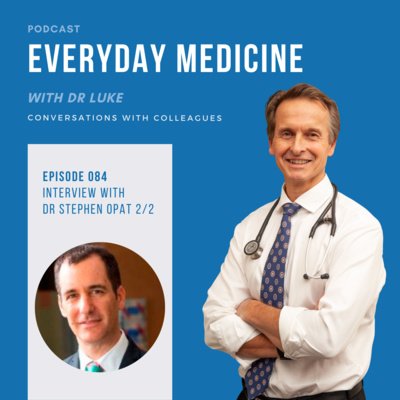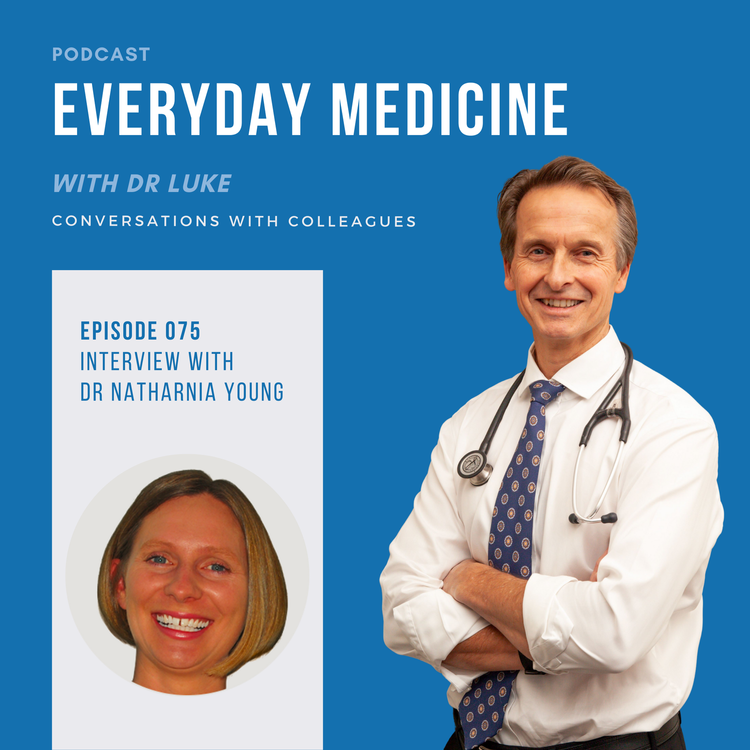Everyday Medicine by Dr Luke Crantock
Conversations with colleagues providing helpful ideas and advice in healthcare
Episode 92. Haemotology with Dr Thomas Lew (Part 2)
In this three-part series we will explore common haematological abnormalities including anaemia, polycythaemia, the basis for neutropenia, neutrophilia, lymphopenia and lymphocytosis as well as thrombocytopenia and thrombocytosis.
Episode 91. Haemotology with Dr Thomas Lew (Part 1)
In this three-part series we will explore common haematological abnormalities including anaemia, polycythaemia, the basis for neutropenia, neutrophilia, lymphopenia and lymphocytosis as well as thrombocytopenia and thrombocytosis.
Episode 90. Venous Thromboembolism with Dr Sanjeev Chunilal
Venous thrombosis affects more than 30,000 Australians each year and is responsible for over 5000 deaths per annum, this is more than the number of Australians who die from motor vehicle accidents annually. VTE is the third leading cause of death amongst hospitalised patients and patients admitted to hospital are at least 100 times more likely of developing a clot compared to being active in the community-a risk that may be assessed by the modified Wells criteria.
Episode 89. Myasthenia Gravis and Gulian Barre Syndrome with Professor Ernest Butler
The Guillain Barre syndrome is an acute inflammatory demyelinating polyradiculopathy and although relatively rare (0.4-2 per 100,000) it is still the most common cause of acute flaccid neuromuscular paralysis worldwide. It famously affected Joseph Heller author of Catch-22 and more recently AFL football Legend Alexander Clarkson. It is an immune-mediated disorder that affects the peripheral nervous system and is another example of molecular mimicry, occurring 1 to 6 weeks after a respiratory infection, Campylobacter enterocolitis, and rarely after trauma or surgery. In 1 in a million cases, GB may develop after the influenza vaccine.
Myasthenia gravis is an autoimmune disorder most commonly observed in women under the age of 40 years and in men over the age of 60 years where antibodies form against the nicotinic acetylcholine receptor at the neuromuscular junction (85% of cases), muscle-specific tyrosine kinase (MuSK 7-10%) or low-density lipoprotein receptor-related protein 4 (LRP 4-5%)-the MuSK 7 and LRP4 are both important to the health of the neuromuscular junction. MG results in muscle fatigue especially of the eyes, facial muscles and bulbar muscles.
To discuss these two interesting conditions we are joined by associate Professor Ernie Butler who is the founder of Frankston neurology group and has major clinical expertise in the management of both acute and chronic neurological conditions, please join me in this conversation with Ernie.
Episode 88. Multiple Sclerosis with Ernest Butler
Multiple sclerosis is an autoimmune neurodegenerative disease of the brain and spinal cord resulting in CNS demyelination affecting 2.8 million people worldwide and 23,000 Australians. There are about 1000 new cases diagnosed in Australia each year and the accumulation of disability can be devastating with an estimated 50 to 80% of patients ceasing full-time work within 10 years. The condition is 3 times more common in women and is most often seen between the ages of 20 and 40 years. The damage in multiple sclerosis is caused by a type IV hypersensitivity reaction and may reflect molecular mimicry with activated T cells crossing the blood-brain barrier and attacking CNS myelin which is produced by oligodendrocytes (myelin in the peripheral nervous system is made by Schwann cells).
Episode 87. Neuroendocrine tumours with Professor Rodney Hicks, Dr Michael Lee and Megan Rogers (Part 2)
Neuroendocrine tumours represent neoplasms of the diffuse neuroendocrine system (DNES) which is our body’s largest endocrine organ comprised of the fascinating amine precursor uptake and decarboxylase (APUD) cell series first described in the 1960s by British scientist A.G.E Pearse. These cells can produce numerous peptides and bioactive amines. Influenced by both the endocrine and nervous systems as well as by the chemistry in their local environment, neuroendocrine cells play a vital role in intracellular signalling and ensure the integrated functioning of many organs and systems within the human body working in both paracrine and endocrine fashion. The signalling molecules produced by the diffuse neuroendocrine system represent a universal chemical language, a vital contributor to the regulation of homeostasis. Cells of the DNES are found throughout the body and are present in almost every organ with well-known examples in the lining of the Gi tract, the lungs, pancreas, thymus, thyroid, brain, adrenal glands etc…
Episode 86. Neuroendocrine tumours with Professor Rodney Hicks, Dr Michael Lee and Megan Rogers (Part 1)
Neuroendocrine tumours represent neoplasms of the diffuse neuroendocrine system (DNES) which is our body’s largest endocrine organ comprised of the fascinating amine precursor uptake and decarboxylase (APUD) cell series first described in the 1960s by British scientist A.G.E Pearse. These cells can produce numerous peptides and bioactive amines. Influenced by both the endocrine and nervous systems as well as by the chemistry in their local environment, neuroendocrine cells play a vital role in intracellular signalling and ensure the integrated functioning of many organs and systems within the human body working in both paracrine and endocrine fashion. The signalling molecules produced by the diffuse neuroendocrine system represent a universal chemical language, a vital contributor to the regulation of homeostasis. Cells of the DNES are found throughout the body and are present in almost every organ with well-known examples in the lining of the Gi tract, the lungs, pancreas, thymus, thyroid, brain, adrenal glands etc…
Episode 85. Pancreatic Cancer with Dr Michael Lee
Pancreatic cancer is the eighth most common cancer reported in Australia. In 2021, it is estimated that there will be 4261 new cases and 3391 deaths. The incidence has increased from 10 per 100,000 in 1982 -to 12 per 100,000 today with the average age of onset between 60 and 65 years. At the time of diagnosis, approximately one-third of patients already have advanced disease with a limited 3 to 4-month survival prognosis, overall, 1-year survival for pancreatic cancer is only 16% and 5-year survival of 3% despite new approaches to management.
Special Episode 11. Anti Virals for COVID-19 with Dr Alex Tai
As case numbers and deaths continue to climb from Covid-19 infection and its many variants, two antiviral drugs have entered the market and are now available on the Australian PBS with specific prescription criteria to be met. So, what are they and what do they do?
Episode 84. Lymphoma with Professor Stephen Opat (Part 2)
Lymphoma is a clonal neoplastic proliferation of lymphoid cells (B cells, T cells and NK cells) and is the sixth most common malignancy reported in this country which makes it the most common hematologic malignancy with over 5000 cases diagnosed each year in Australia putting lifetime risk at 1 in 50.
Episode 83. Lymphoma with Professor Stephen Opat (Part 1)
Lymphoma is a clonal neoplastic proliferation of lymphoid cells (B cells, T cells and NK cells) and is the sixth most common malignancy reported in this country which makes it the most common hematologic malignancy with over 5000 cases diagnosed each year in Australia putting lifetime risk at 1 in 50.
There are over 70 different types of lymphoma which are divided into 2 main groups: Hodgkin's lymphoma accounts for 10% of cases and non-Hodgkin's lymphoma accounts for 90% of cases.
Hodgkin's lymphoma named after Thomas Hodgkin (1832) is more common in men, and tends to occur at a younger age than non-Hodgkin's lymphoma with a bimodal age distribution but the average age at diagnosis of 39 years and involves lymph nodes frequently on just one side of the body usually above the diaphragm. The tumour cell is referred to as the Reed Sternberg cell which is a bi or multi-nucleated B cell comprising characteristically just 1% of the lymphoma mass. Just to make this nomenclature interesting there is classic Hodgkins which make up about 95 % of cases and of which nodular sclerosing comprises about 70 % and mixed cellularity 20-25 % and non-classic Hodgkins is characterised by nodular lymphocytic predominant pathology.
Special Episode 10. Monkeypox and Japanese Encephalitis with Dr Alex Tai
In May this year, new cases of the rare infection-Monkey Pox - typically limited to Africa, began spreading within Europe and North America.
More than 780 cases have now been reported across 15 countries with Australia recently reporting 8 cases.
Monkeypox is a viral zoonotic disease, a member of the same family of viruses as smallpox and typically is spread through close physical contact with skin lesions, body fluids, respiratory droplets, and contaminated materials such as bedding and is much less infectious than respiratory illnesses such as Covid 19. Transmission of Monkey pox virus by respiratory droplets would normally require prolonged face-to-face contact, so the apparent rapid spread of the virus may signal a shift in its behaviour and some scientists have questioned if the virus may have mutated to become more transmissible. Two strains have been identified.
Episode 82. Advances in Anti-ageing Medicine with Dr John Levin
Dr John Levin practices antiaging medicine and joins this podcast to discuss his practical approach to treatment. As John laments antiaging medicine is not taught in medical school yet he believes the science of anti-ageing holds the key to significantly reducing human suffering and improving health span. Whilst the average human life span continues to increase and modern medicine more efficiently tackles diseases, the science of anti-ageing looks at mechanisms leading to cell degeneration and decay and seeks ways to regenerate cell health and thereby delay the many diseases associated with ageing.
Episode 81. Polycystic ovary syndrome (PCOS) with Dr Mei Cheah
PCOS is the most common endocrinopathy of reproductive age women affecting about 1 in 10. Characteristically the condition presents with menstrual irregularity, excess androgens, and polycystic ovarian morphology. More common in women with a family history and type 2 diabetes the condition is associated with obesity, infertility, pregnancy complications and metabolic derangements as well as a number of psychological consequences.
In this podcast we have a conversation with obstetrician and gynaecologist Dr Mei Cheah founder of Create Health a leading group of specialists in women's health creating visions for a healthy future, better well-being, and more informed patients. Create Health aims to deliver exceptional care across obstetrics, gynaecology, reproductive endocrinology, minimally invasive surgery, fertility and IVF plus allied and complimentary health services. We look forward to exploring the practical aspects of this diagnosis further with you.
Episode 80. Endometriosis with Dr Mei Cheah
Endometriosis is the presence of endometrial tissue outside the uterus or embedded within its muscular wall. This unusual condition is known to induce a chronic inflammatory reaction that may be associated with pelvic pain and infertility. In women of reproductive age the estimated prevalence is 7 to 10% and up to one third of women undergoing laparoscopy for pelvic pain are diagnosed with endometriosis. Endometrial deposits may be deeply infiltrating, found in the abdomen and pelvic region may be invading the ovary but also found in the lungs, pleura and on the diaphragm. Ectopic endometrial tissue within the uterine myometrium is referred to as adenomyosis and may be responsible for heavy menstrual bleeding, some estimates place adenomyosis with a prevalence of 20 to 28%.
Episode 79. Investigations in Rheumatology with Dr Andrew Teichtahl
In this episode we explore investigations in rheumatology - What is helpful and what is not?A clinician faced with a patient complaining of myalgias and generalised rheumatic aches may be tempted to order a host of immunological and inflammatory tests whilst also assessing multiple other differential diagnoses that need considering. There are a host of serological tests available each with different degrees of sensitivity and specificity for rheumatological conditions, furthermore it is important to understand the sensitivity (ability to rule out condition) and specificity (ability to rule condition in) is applied to such tests. Fortunately, we had the opportunity to have a conversation with Dr Andrew Teichtahl who provides excellent clarification on the subject.
Episode 78. New Agents in Rheumatology with Dr Andrew Teichtahl
The past two decades have witnessed dramatic changes in the approach to managing rheumatologic conditions, born of a wider understanding of cellular biology, immunology, and the pathophysiology of inflammation we have consequently seen an explosion in the development and availability of both Biologic medications and small molecules for medical applications.
Episode 77. The Microbiome with Dr Mark Morrison
Trillions of microbes are living in and on us, a thriving ecosystem of bacteria, viruses, archaea and fungi. Collectively these microbes form the human microbiome and this microbiome appears to play a key role in many aspects of health, crowding out harmful microbial invaders, breaking down fibrous food into digestible compounds and producing some essential vitamins such as B12 and vitamin K. New research is exploring the relationship between the gut microbiome and immunogenicity, autoimmune inflammatory diseases, neoplasia and brain development and is searching ways to correct dysbiosis.
Episode 76. Breast Cancer with Dr Corinne Ooi
Breast cancer affects 1 in 7 women and remains the most diagnosed cancer in Australia with 57 new cases diagnosed each day, 1000 new cases per year and tragically 2000 deaths annually. Men are not excluded, for every 100 breast cancers one is diagnosed in a male. Genetic links for breast cancer such as the BRCA 1 and 2 genes receive significant attention but account for only 5% of total cases,75% of patients have no family history and additionally 75% of breast cancers are diagnosed in patients 50 years or older. Multiple risk factors including family history, young age of menarche and older age of menopause are frequently cited but less well known is the association with obesity which is responsible for up to 8% of all breast cancers. It is estimated that 1: in 4 cases of all breast cancer may be prevented with attention to known modifiable risk factors. Breastfeeding and earlier age of pregnancy are both protective factors.
Episode 75. Urinary Incontinence in Women with Dr Natharnia Young
Dr Natharnia Young is a leading urogynaecologist servicing South Eastern Melbourne’s suburbs and joins this conversation to discuss urinary incontinence in women, a condition associated with significant personal and social stigmatisation and affecting up to 1:2 women over the age of 70.




















